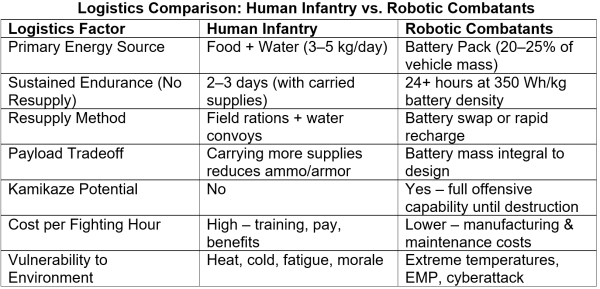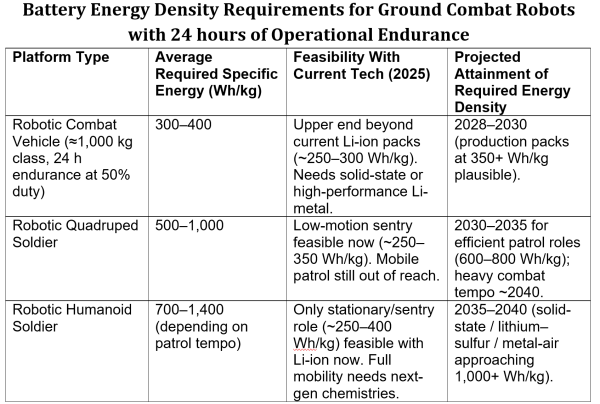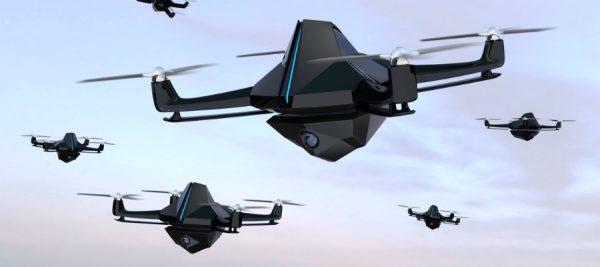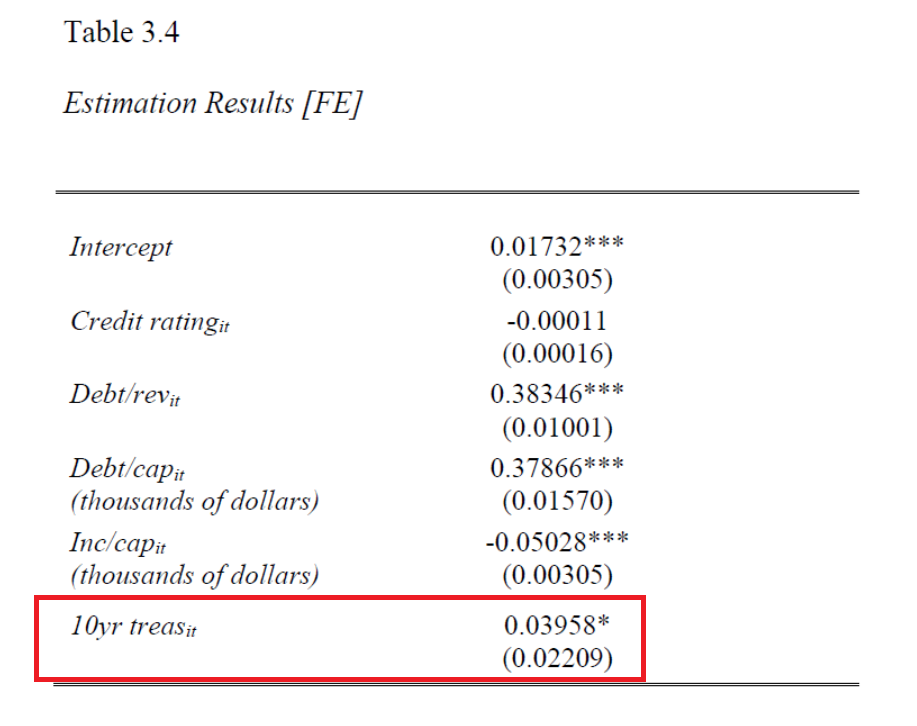
Armored knights vanished when gunpowder weapons made them ineffective, and cavalry vanished when motorized transport and tanks arrived on the battlefield. I believe infantry will likely be the next category of warriors to disappear. History shows that survival, cost-effectiveness, and competitive advantage dictate military force composition—not tradition. The lessons are clear: when a combat role becomes too costly and too vulnerable compared to alternatives, it disappears. I will explain why trends in battery technology, robotics, and artificial intelligence are converging toward a point where humans will not be able to survive in front line combat. In their place, armies of robotic combatants will clash on future battlefields, and their deadly potential will alter geopolitics, for good or ill.
Human Frailty
The human soldier has many drawbacks. He or she is difficult to train, costly to maintain in peacetime, and difficult to sustain on the battlefield. Soldiers vary in health, strength, intelligence, and motivation. They can be defeated by exhaustion, mismanagement, or panic. Desertion, mutiny, and war crimes may occur among demoralized or undisciplined troops. When engaged in combat, soldiers require sleep, food, water, ammunition, fuel, and medical care. Because of psychological stress, they must be rotated out of the front line periodically to avoid becoming psychiatric casualties. Armies have evolved methods and doctrines for managing large groups of soldiers to offset these weaknesses, but the underlying problems remain.
Machine Advantages
The advantage of robotic soldiers over human infantry are numerous. Consider the basic logistics of sustaining a soldier in combat. A robotic system that needs no sleep, food, or water has obvious advantages over a human soldier. Broadening the comparison to encompass training, medical care, and retirement benefits makes the comparative advantage overwhelming for robotic soldiers.
The Technological Drivers of Change
1. Battery Energy Density
The main obstacle to the large-scale deployment of ground-based military drones is battery energy density. A mid-size autonomous ground combatant, such as a tracked or wheeled platform with armor and integrated weapons, would require roughly 5–8 kW of continuous power for mobility, targeting sensors, and onboard computing, plus bursts of 15–20 kW for sprinting, climbing, or active weapon use.
Baseline endurance target:
• 24 hours of intermittent movement and combat readiness (≈50% duty cycle).
• Energy requirement: 60–80 kWh total stored energy.
Battery density requirement:
• Assuming a 1,000 kg combatant with 20–25% of mass allocated to energy storage, the battery pack must deliver 300–400 Wh/kg to sustain 24-hour operation without resupply.
Current status (2025):
• Commercial lithium-ion: ~250–280 Wh/kg (Tesla 4680-class cells).
• Military-grade Li-ion/Li-poly packs: ~260–300 Wh/kg.
• Lab prototypes (Li-metal / solid-state): 400+ Wh/kg demonstrated in small cells.
Trendline projection:
• Historical gain: ~5–7% per year in practical fielded densities.
• Threshold for 24-hour autonomous combat operations (≈350 Wh/kg) likely to be met in 2028–2030 for production-grade packs.
At that point, a fully autonomous mid-weight robotic combatant will be able to maneuver and fight for an entire operational day without human resupply—removing one of the last logistical advantages of human infantry.

Humanoid or quadruped combat robots would have greater energy density requirements to attain a 24 hour operational capability without power recharge/replacement, but technology projections indicate that this level of battery power density will be attained within the next two decades. Enormous investments in battery technology are being made worldwide by the auto industry, and their technology advances will be exploited by robotic arms makers.

2. Autonomous Robotic Systems
Miniaturized actuators, lightweight materials, and adaptive AI will enable agile, stealthy, and precision-capable war machines. These systems will increasingly operate in swarms, with distributed lethality enabled by tactical coordination. The electro-mechanical problems have already been solved for a variety of combat robot types, and the necessary machine vision and combat mission software is well within the current AI state of the art. Thus many of the technical prerequisites for robotic soldiers are in place. Based on the emergence of aerial drones as a significant battlefield presence in the Ukraine war, military establishments worldwide are pouring resources into research and development of robotic combat systems.
3. Weapons Lethality and Precision
The proliferation of relatively cheap, high-accuracy drones, loitering munitions, and autonomous targeting systems will create an environment where battlefield survival time for a human combatant approaches zero. Sensor fusion and persistent surveillance ensure that once detected, targets can be engaged almost immediately by robotic systems. There is no vehicle or body armor that is immune to drone-delivered explosives, and even the most robust fortifications can be shattered or overwhelmed by a robotic attack. A decisive advantage is the kamikaze potential: autonomous units can function as sacrificial precision munitions at any moment, forcing adversaries to treat every robotic presence as an immediate threat. There will be nowhere to hide for human combatants, and small chances of surviving robotic precision strikes.
The Shape of Soldiers to Come
The synthetic evolution of robotic warriors will likely result in a variety of species, some airborne, some land-bound, and some with multiple mobility modes. Armament will range from conventional guns and missiles to non-lethal incapacitating weapons. Self-destruct capability will be a common feature for providing a kamikaze option. The main evolutionary branches will be aerial and ground-based, just as in the animal kingdom. Flying drones will excel at reconnaissance and distant strike tasks. Wheeled, tracked, bipedal, or quadruped drones will likely handle ground transport and logistics work, positional defense, and direct assaults. There may also be hybrid robotic combatants, such as vehicles that can carry and launch aerial drones. In parallel with the physical evolution of combat drones, there will be an evolution of drone intelligence as it moves up the gradient of capability from basic tasks, to tactical coordination, to strategic decision making.

Death from above

The dogs of war
The Battlefield of the Near Future
Future battlefields will be hostile to human presence—persistent surveillance, omnipresent drones, and automated fire control will make concealment and evasion nearly impossible. Many robotic units will have the capability to act as a munition, making retreating or damaged robots dangerous until neutralized. Human infantry will find survival, let alone effectiveness, increasingly untenable. The tempo of combat will increase beyond current norms because robotic soldiers will operate around the clock, pausing only briefly for battery replacement or recharging. Tactical decision making will be done in milliseconds, and combat engagements are likely to be short, intense, and decisive.
As unmanned combat systems become increasingly capable of tactical and strategic decision making, the high speed of their information processing raises the possibility of runaway escalation of conflicts originating in accidental or erroneous initial fighting. The design of safety mechanisms and escalation circuit breakers will be a critically important task for future developers and operators of autonomous military combatants.
The condition of civilians in war zones where robotic systems are active is a matter of great concern. There is no body of international law governing the actions of robotic soldiers toward civilians. Existing laws, such as the Geneva Conventions, will require modification to govern autonomous weapons and assign responsibility to those who operate them. Irregular warfare, such as guerrilla or partisan resistance will pose just as difficult a problem for robotic troops as it has for human soldiers. How will they decide if a civilian is a threat, and who will be accountable if the wrong decision is made?
Armed forces will restructure to integrate robotic maneuver brigades, autonomous patrol and denial zones, and remote human command roles. Kamikaze-enabled doctrine will favor attrition by material depletion rather than personnel loss. Logistics will prioritize energy and parts supply over food and medical evacuation. Although many near term changes can be foreseen, the secondary and tertiary effects of drone-based armed forces are difficult to predict. The replacement of human infantry with robotic combatants will have far-reaching geopolitical consequences. I will describe some possible outcomes in both negative and positive categories.
Consequences That Could Increase the Likelihood of Warfare
Lowering Political Cost of War – Politicians would face minimal domestic backlash when combat deaths are limited to machines, making the initiation of military action more palatable. Wars over marginal interests may become more common, with a higher risk of miscalculation and dangerous escalation.
Acceleration of Proxy Warfare – States can supply allied factions with robotic units without committing troops, expanding the frequency and scope of proxy conflicts. These wars would become proving grounds for new autonomous systems.
Collapse of Small-State Deterrence – Mass production of robotic soldiers by wealthy states undermines poorer states’ ability to deter aggression, increasing their vulnerability to coercion or invasion.
Strategic Re-weighting Toward Industrial Capacity – Military power increasingly depends on the ability to produce and maintain autonomous forces, shifting global influence toward nations with advanced manufacturing and critical resource control.
Erosion of International Law Norms – Existing laws of armed conflict are poorly suited to regulating autonomous warfare, leading to greater ambiguity in proportionality, combatant status, and civilian protection.
Proliferation and Insurgent Adaptation – Non-state actors acquire stolen or black-market autonomous units, adapting them for asymmetric attacks and terrorism.
Shifts in Alliance Dynamics – Alliances redefine military contributions in terms of robotic units rather than troop numbers, creating new coalitions and potential trust issues over proprietary technologies.
Consequences That Could Decrease the Likelihood of Warfare
Strategic Deterrence Through Overmatch – If major powers field highly capable robotic forces, the prohibitive cost of invasion may deter open conflict, much like nuclear deterrence in the Cold War.
Economic Interdependence of Robotics Supply Chains – The globalized nature of robotic systems manufacturing creates mutual dependency; war would disrupt both sides’ capabilities, discouraging escalation.
Deterrence via Escalation Risk – Autonomous systems with persistent surveillance remove plausible deniability for border violations, deterring provocations. Danger of uncontrolled escalation raises risks of armed confrontation.
Shift to Non-Kinetic Competition – The dominance of robotic forces reduces the strategic payoff of kinetic war, shifting competition toward cyber, electronic, and economic domains.
Conclusion
The displacement of human infantry by robotic combatants is not a distant hypothetical—it is an emerging military reality shaped by predictable technological and economic trends. The consequences will vary widely depending on how states integrate these systems into doctrine, how military alliances adapt, and how international law evolves to address robotic systems in warfare. While the transformation carries significant geopolitical risks, it also presents possibilities that could stabilize relations among states. In any event, the future fate of human foot soldiers will be what was described in a farewell speech by General MacArthur: they will just fade away.


